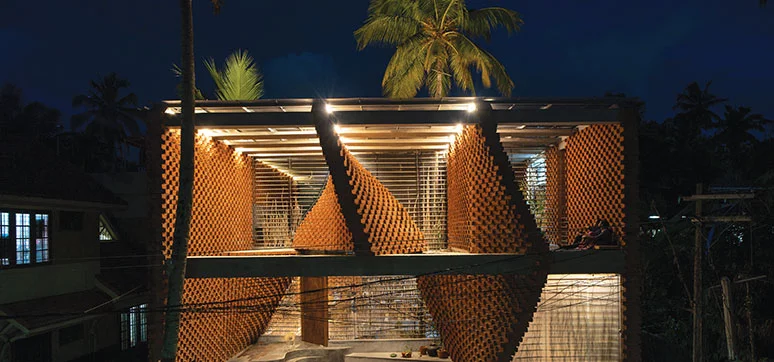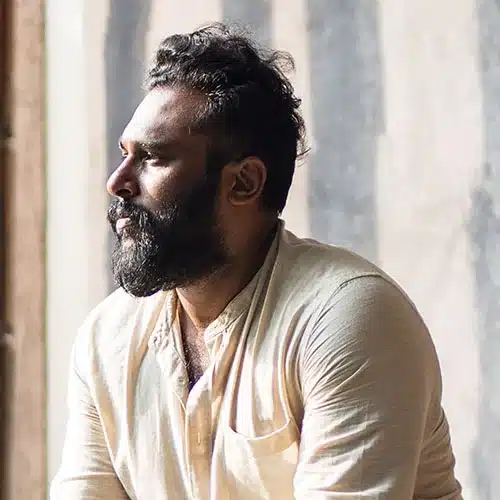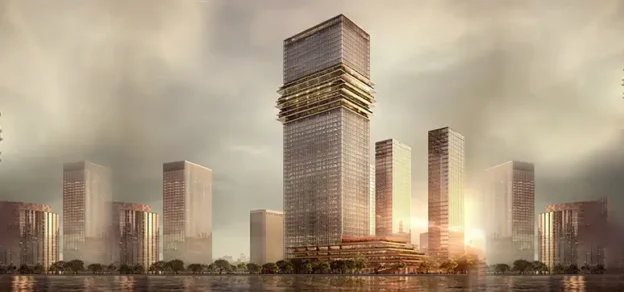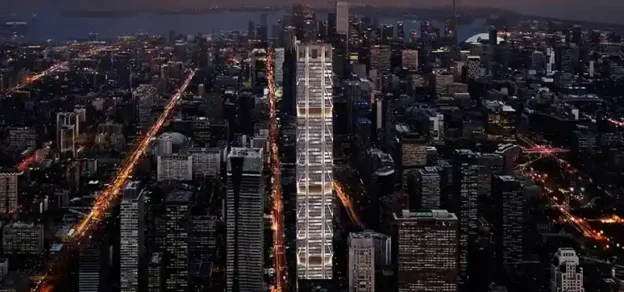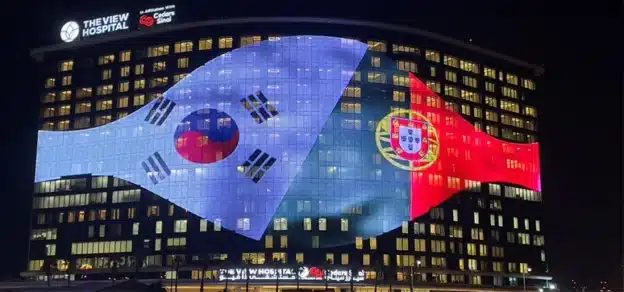Pirouette House, Trivandrum
Located smack in the middle of an urban and crowded locale of Trivandrum, the site was a small plot that was being suffocated by other residential projects from all four sides. The idea of this residence was to have an inward-facing house with all its spaces opening into a funneling central courtyard. The house is aligned in the east-west direction with openings facilitating maximum cross-ventilation.
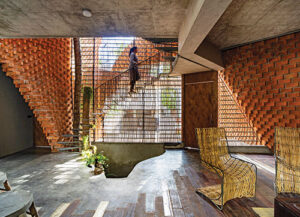
In the context of the city of Trivandrum that stands as a testimonial to many of Ar. Laurie Baker’s masterpieces, this project seemed fit to modify one of his own introductions, the ‘Rat trap bond brick masonry’ technique in this site which didn’t offer the opportunity for soil excavation or for making mud blocks. Keeping in mind that brick kilns in Trivandrum are a dying industry with people opting out for wire-cut machine-made bricks, this was also an attempt to promote this local agriculture-based industry that is on the brink of extinction.
The ‘Rat trap bond’ is a brick masonry method of wall construction in which bricks are placed in a vertical position instead of a conventional horizontal position and thus creating a cavity within the wall that increases thermal efficiency, cuts down on the total volume of bricks used, and is ideal for concealing structural members and service ducts. The idea was further developed to form a series of slanting walls that danced left and right, converging only to support the ferrocement shell roof. Each staggered wall has been tailor-made to suit the issue of deficiency in space that this residence posed, aiming to create larger volumes and a feeling of privacy.
Scaffolding pipes left behind from the construction stage soon were reused to form the central staircase and the grillwork. Keeping in mind the principle of discarding nothing as ‘waste’ the wooden planks were also pieced together to form part of the flooring in the living areas.
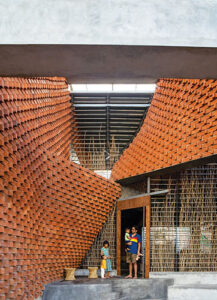
Cane has been acquired from the neighbourhood, treated, and wound around the grillwork to create subtle screens for privacy and for various furniture.The Pirouette House features the “Last of the Mohicans” fired bricks as an ode to the stellar practice of Laurie Baker with spaces that are made beautiful by the pure geometry and patterns created by the walls that seem to be coming alive and pirouetting around.
Materials Used in Construction:
1. Fired bricks for Rat Trap bond brick masonry: Rat trap bond is a brick masonry method of wall construction introduced by Laurie Baker in Kerala, in which bricks are placed in a vertical position instead of a conventional horizontal position and thus creating a cavity (hollow space) within the wall that increases thermal efficiency and cuts down the number of bricks.
2. Waste wood: Cut wooden scrap pieces have been joined to panel a part of the flooring.
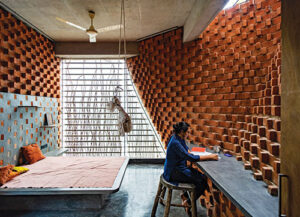
3. MMT Ferrocement shells: These wafer-like structures are steel-reinforced arched shells with an effective thickness of 2.5cm and they take an equal load of respective R.C.C slabs. They effectively reduce the overall cement consumption by 40% and steel consumption by 30%. These replace the R.C.C Slab in roofing as they are as strong as 1200 kg/m2
4. Discarded Scaffolding Pipes for Staircase and Grillwork: The staircase and the grillwork of this house have been made entirely out of scrap scaffolding pipes that have been welded in place.
5. Oxide: The floor and selected walls have been finished with grey and yellow oxides.
6. Cane: Cane has been treated and woven together in between the grillwork to act as a partial screen for privacy.
QUICK FACTS:
- Project: Pirouette House
- Project Location: Maruthamkuzhi, Trivandrum, Kerala
- Client: Mr Kiran
- Architectural firm: Wallmakers
- Lead Architects: Ar. Vinu Daniel Gross
- Built Area: 196 sqm
- Materials used for facade & fenestration: Rat trap bond brick masonry with Wire-cut machine-made bricks, Scaffolding pipes, and Treated Cane.
- Other consultants: Engineering: Adcons Infrastructure Pvt Ltd
- Landscape: Vinu Daniel and team
- Fabrication team: Kunjumon James and team – J.K Steels
- Commencement Date: April 2018
- Completion Date: September,.2020
- Photo credits: Jino Sam
Brimming with Nature Shikhara, Trivandrum
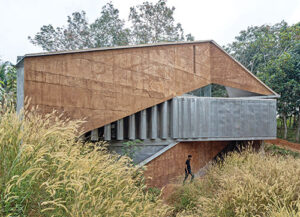
Set against one of the silent hilltops of Trivandrum, the site was located at the highest point in that particular part of the woods. The client was somebody who loved to travel and planned frequent escapades to distant lands, all over the country. The Himalayas had always caught his attention and intrigued him the most and he was lucky that his abode too would be just as reclusive, set on the lovely hilltop.
However, being a west-facing site one would have to hold up a hand to shield their eyes from the harsh west sun. That ‘hand’ was reimagined as a slanting wall along the site giving birth to the concept of conceiving the residence as – Shikhara (the Peak)
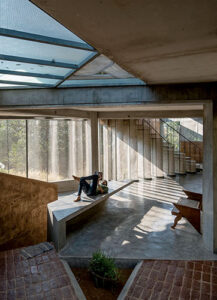
The wall, brutal but a shade from the harsh heat and direct sunlight was to be made from the materials procured from the land itself, this being a prerogative of Wallmakers as we exclusively indulge in sustainable building practices. The soil procured by excavating the rainwater harvesting tank and the basement floor however presented an opportunity in the guise of a problem. The rocky terrain soil was filled with pebbles and debris which was deemed unsuitable for making mud bricks. Therefore, the patented technique of Shuttered Debris Wall was used here. Thus the slanting waste material wall and a view to withhold were born.
Since the major length of the building ran along the westside as a solid wall with small openings, lack of cross-ventilation posed a new problem. After foraging in the market the answer rose in the form of Aluminium coin sheets that were perforated to let in light and air. A rhythmic undulating pattern was worked out on it so that this facade doubled up to become the staircase and answer the security concerns.
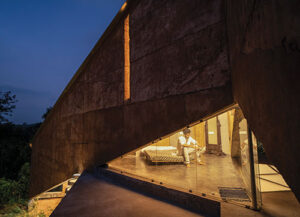
The overall experience of living in this residence can indeed be compared to that of being in the mountains- Brimming with nature but also formidable, welcoming but reclusive, and above all – a quiet viewpoint to view the countryside.
Materials Used in Construction:
1. Shuttered Debris Wall: This wall construction technique involves mixing cement, soil, and waste materials of various sizes(coarse aggregate) ranging from 10mm -70mm skilfully to give a strong wall ( 5.2MpA compressive strength)
What is waste? Waste can be classified as anything that was produced, used, and then discarded from its original function. While the work and construction process results in the production of a lot of scraps, we believe in not being deterred by this demon and instead of building with it
2. Waste wood: Cut wooden scrap pieces have been joined to make furniture like beds kitchen cabinets, doors, etc.
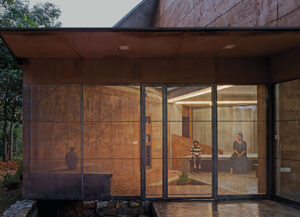
3. Aluminium coin sheet: The perforated sheets of aluminium act as a semi-transparent screen, allowing us to have a clearer view of the exterior.
4. Cement Board: The interior bridge and the staircase treads are made out of cement fiberboard with polish to finish.
5. Oxide: The floor and selected walls have been finished with grey and white oxides.
QUICK FACTS:
- Project: Shikhara
- Location: Trivandrum, Kerala
- Client: Mr. Harikumar Karunakaran
- Architect’s Firm: Wallmakers
- Lead Architects: Ar. Vinu Daniel
- Materials used for facade & fenestration: Shobri Walls, Perforated sheet
Other consultants :
- Engineering: Adcons Infrastructure Pvt Ltd
- Landscape: Vinu Daniel and team
- Fabrication team: Kunjumon James and team -J.K Steels
- Commencement Date: February 2017
- Completion Date: December 2019
- Gross Built Area: 177.29 sqm
- Photo credits: Jino Sam, Siddharthan, Chirantan Khastgir, Akash Sharma, and Sagar Kudtarkar
